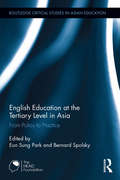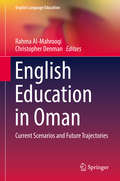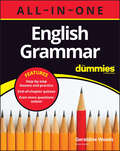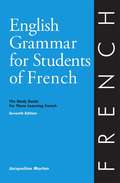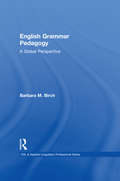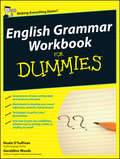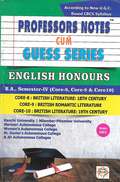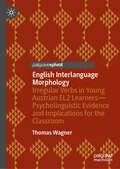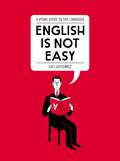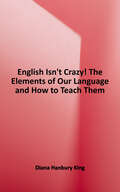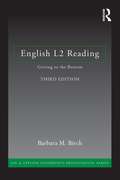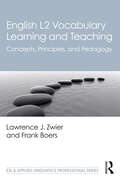- Table View
- List View
English Education and the Radicals: 1780-1850 (Routledge Library Editions: Education)
by Harold SilverThe radicalism of the period from the 1780s to the mid-nineteenth century represented a harnessing of knowledge in protest against injustices and oppression, a pooling of effort to transform society. In this book the author explores the main strains in working and middle-class radicalism over this crucial period, with emphasis on the educational ideas and activities of radical movements, their spokesmen and ideologies. The author stresses some of the central educational interests of radical movements through the radical organizations of the 1780s and 1790s, and early nineteenth-century political and social movements, including the utilitarians, Owenites, Chartists and Tory radicals. He discusses educational ideas and action with regard to infants and adults, basic literacy and political understanding, examines some of the forms of study, self-education and propaganda to political action. This book is a study in miniature of the processes of political and social change in a period of industrial, political and social revolution – its theme is education in its widest sense.
English Education at the Tertiary Level in Asia: From Policy to Practice (Routledge Critical Studies in Asian Education)
by Bernard Spolsky Eun Sung ParkThis is the third volume of a trilogy on English Language education in Asia within the Routledge Critical Studies in Asian Education. Put together by editors and contributors selected by Asia TEFL, this book provides a timely and critical review of the current trends in tertiary level English education in Asia. It foregrounds the developments and trends, policies and implementation, as well as research and practice. Written by ELT scholars and educational leaders, this book presents articles on China, Hong Kong, India, Japan, Korea, Malaysia, the Philippines, Singapore, Thailand, and Vietnam. While the authors focus on their own local issues, providing an overview of the state of tertiary English teaching in their respective territories, they also provide insights from their successes and failures which can help inspire solutions to similar challenges faced internationally in the field. Chapters in the book include: • Heading toward the global standardization of English education in Korean universities • English in tertiary education in India: A Janus-faced perspective with special reference to University of Delhi • Developing English language skills in the Singapore higher education context • ELT at tertiary institutions in China: A developmental perspective This book will be valued by administrators, researchers and scholars interested in bilingualism, language policy and planning in higher education.
English Education in Oman: Current Scenarios and Future Trajectories (English Language Education #15)
by Rahma Al-Mahrooqi Christopher DenmanThis book explores an area that has been somewhat overlooked in the literature to date – the current status and future trends of English education in Oman. It offers a variety of theoretical and methodological approaches to the subject and explores areas of English education in Oman that have, until now, been little investigated. It explores these issues from a variety of perspectives: the professionalization of English teachers in the country; the implementation of novel teaching methodologies, curricula, and assessment approaches, into what are, in many ways, still very traditional education settings; the integration of learner identity into English language instruction; country- and culture-specific concerns with conducting research with Omani participants; the strategic demands of building stronger links between education and workforce needs; and developing learner autonomy and motivation.
English First Language - IGCSE
by John ReynoldsThe textbook by IGCSE for English inspires students with a new Theme-based approach while supporting them with practical advice and accessible explanations. It ensures full coverage of the latest Cambridge IGCSE first language English syllabus (0500/0990) with a fully updated student's book, written by an experienced author and examiner. It motivates students with engaging themes such as travel and exploration and people and community. Develop reading Comprehension, analysis and Evaluation with a variety of text types and genres, plus annotations to aid understanding. Improve writing skills with Model responses and teacher commentary, and establish a strong background in spelling, punctuation and grammar. Expand communication skills with advice on holding presentations and responding to questions confidently. Consolidate learning with activities and study tips, as well as extra questions, practice tests and answers to selected questions online.
English Grammar All-in-One For Dummies (+ Chapter Quizzes Online)
by Geraldine WoodsLearn to get your ideas across clearly and correctly—the easy way English Grammar All-in-One For Dummies is packed with everything you need to know to communicate with confidence—in your writing, on standardized tests, at work, on social media, and everywhere else. Strong verbal and written skills can help you get where you want to be, and this easy-to-understand Dummies guide will help you understand the English grammar principles you need to know so you can improve your understanding of basic grammar and punctuation rules, easily identify parts of speech, and communicate more effectively. Learn the basics of punctuation—periods, commas, semicolons, and beyond Write clearer e-mails and messages, or ace the writing section of your test Navigate pronouns and make sure you’re using inclusive language Practice with end-of-chapter quizzes and even more online practiceEnglish Grammar All-In-One For Dummies is an excellent resource for students, professionals, job seekers, non-native-English learners, and anyone who wants to brush up on using this crazy language we call English.
English Grammar For Students of French (Seventh Edition)
by Jacqueline MortonEnglish Grammar for Students of French (EGSF) is a bridge from English grammar to French grammar. Once you have learned a part of speech or a function as it applies to English, it will be easier for you to understand what is being introduced in your French textbook. Each short chapter is divided into two sections, In English and ln French, both explain the same grammar point and alert you to the similarities and differences between the two languages. You will find step-by-step tools to apply grammar rules and to get from an English structure to a French structure.
English Grammar Pedagogy: A Global Perspective (ESL & Applied Linguistics Professional Series)
by Barbara M. BirchDesigned for ESL and ELT pedagogy courses around the world, this text describes English grammar from a World Englishes perspective. It is distinguished by its focus on the social setting for English as a global language, the latest thinking about grammatical theory, and new theories of how first and second languages are learned and taught. The fundamental premise is that teaching and learning grammar cannot be isolated from the local, regional, and global sociocultural contexts in which the teaching and learning take place. Part I presents different attitudes toward English as a global language and some challenges that learners of English share no matter where they are in the world. Part II is about the features of English that educated speakers consider the most likely and probable in Academic English. Part III describes the flexible and fluid features of English that might be susceptible to change or modification over time. Each chapter includes engaging Study, Discussion, and Essay Questions and Activities.
English Grammar Workbook For Dummies
by Geraldine Woods Nuala O'SullivanEnglish Grammar Workbook For Dummies, UK Edition is grammar First Aid for anyone wanting to perfect their English and develop the practical skills needed to write and speak correctly. Each chapter focuses on key grammatical principles, with easy-to-follow theory and examples as well as practice questions and explanations. From verbs, prepositions and tenses, to style, expressions and tricky word traps, this hands-on workbook is essential for both beginners looking to learn and practise the basics of English grammar, and those who want to brush up skills they already have - quickly, easily, and with confidence. English Grammar Workbook For Dummies, UK Edition covers: Part I: Laying the Groundwork: Grammar Basics Chapter 1: Placing the Proper Verb in the Proper Place Chapter 2: Matchmaker, Make Me a Match: Pairing Subjects and Verbs Correctly Chapter 3: Who Is She, and What Is It? The Lowdown on Pronouns Chapter 4: Finishing What You Start: Writing Complete Sentences Part II: Mastering Mechanics Chapter 5: Exercising Comma Sense Chapter 6: Made You Look! Punctuation Marks That Demand Attention Chapter 7: One Small Mark, a Whole New Meaning: Apostrophes Chapter 8: "Let Me Speak!" Quotation Marks Chapter 9: Hitting the Big Time: Capital Letters Part III: The Pickier Points of Correct Verb and Pronoun Use Chapter 10: The Case of It (And Other Pronouns) Chapter 11: Choosing the Best Pronoun for a Tricky Sentence Chapter 12: Travelling in Time: Tricky Verb-Tense Situations Chapter 13: Are You and Your Verbs in the Right Mood? Part IV: All You Need to Know about Descriptions and Comparisons Chapter 14: Writing Good or Well: Adjectives and Adverbs Chapter 15: Going on Location: Placing Descriptions Correctly Chapter 16: For Better or Worse: Forming Comparisons Chapter 17: Apples and Oranges: Improper Comparisons Part V: Writing with Style Chapter 18: Keeping Your Balance Chapter 19: Spicing Up and Trimming Down Your Sentences Chapter 20: Steering Clear of Tricky Word Traps Part VI: The Part of TensChapter 21: Ten Over-corrections Chapter 22: Ten Errors to Avoid at All Cost
English Grammar and Teaching Strategies: Lifeline to Literacy
by Joy Pollock Elisabeth WallerEnglish Grammar and Teaching Strategies aims to demystify grammar and equip any teacher to teach it in the classroom. Carefully set out for ease of reference, this book covers every aspect of grammar, from nouns, adjectives and verbs to punctuation and prepositions. Each grammatical term is clearly defined and accompanied by varieties of usage and teaching strategies, which can be easily extended according to the age and key stage of the pupil. These strategies are for both spoken and written language and can be used for a whole class, small groups, with those with special educational needs and with EAL learners. Featuring a brand new preface by Jo Shackleton, this Routledge Classic Edition is an indispensable resource for all teachers in both primary and secondary schools.
English Grammar for Students of Spanish (Seventh Edition)
by Emily SpinelliThousands of students have found this book the ideal way to master and upgrade their Spanish grammar.
English Grammar: 100 Tragically Common Mistakes (and How to Correct Them)
by Sean WilliamsThe practical English grammar guide for perfect writing.Gone are the days when you worry about embarrassing yourself with pesky misplaced modifiers or dreaded double negatives. Next time you have a nagging grammar question, pick up this practical guide and write with clarity and confidence.English Grammar spares you the lessons and cuts right to the answers. Designed for fast reference, this book makes it easy to avoid the most cringe-worthy mistakes in the English language—and maybe even make your grade school grammar teacher proud.Inside English Grammar:English Grammar goofs—Avoid falling into the most common traps with guidelines for incomplete sentences, possessive pronouns with gerunds, dangling modifiers and more.Word mix-ups—Learn the difference between common word misuses like sex vs. gender, its and it's, whose and who's, the list goes on…Write with style—Make a good (and grammatically correct) impression with every sentence you pen using these easy writing hacks and suggestions.Everyone makes mistakes—but with this English grammar guide you'll make a lot fewer of them. Period.
English Homework for Key Stage 2: Activity-Based Learning (Active Homework)
by Colin Forster Vicki Parfitt Andrea McGowanEnglish Homework for Key Stage 2 is a unique resource for busy teachers - a selection of ‘pencil-free’, hands-on activities, aligned with the National Curriculum Programmes of Study and with clear links to the topics set out in the PNS Framework for English, that teachers can use as extension activities or give to pupils as homework to do with members of their family or friends. Each of the activities encourages the pupils to learn through discussion and through practical activities utilising everyday resources. Each activity is quick and easy for pupils and teachers to manage, and includes: a learning aim, full, clear instructions and discussion points tasks to foster collaboration and partnership between pupils, parents and teachers photocopiable resources. A refreshing approach for teachers and pupils, these activities will foster enthusiasm for learning and inspire pupils' interest in English.
English Honours BA Sem-IV (Core - 8, 9 and 10) - Ranchi University N.P.U
by Kanhaiya Book Distributorss RanchiEnglish Honour's textbook According to the New Syllabus Based on U.G.C. Model Curriculum Choice Based Credit System (CBCS) for B.A. Sem-IV (Core-8, Core-9 & Core-10) from Ranchi University, Nilambar Pitambar University in English.
English Humanism: Wyatt to Cowley (Routledge Revivals)
by Joanna MartindaleThe literature of the English Renaissance demands some attention to the intellectual and educational background which produced it, in order to be seen in proper perspective. The selection in this book, originally published in 1985, both illustrate the intellectual climate of the English Renaissance and exemplify some of its characteristics, though not strictly literary products. These include education, classicism and imitation, wisdom and eloquence, history and moral philosophy, religion and vernacular scripture. Erasmus has been given a dominant place in the anthology as the main mediator of humanist ideas to England; other authors represented include Castiglione, Machiavelli, Sir Thomas Elyot, Roger Ascham and Ben Jonson. This volume charts precisely the debt of English Renaissance literature to Continental Humanism and the classical revival and is a valuable contribution to an understanding of the literature and society of the time.
English Interlanguage Morphology: Irregular Verbs in Young Austrian EL2 Learners—Psycholinguistic Evidence and Implications for the Classroom
by Thomas WagnerThis book examines psycholinguistic elements of irregular verb morphology in English, using two empirical studies of young language learners in Austria to make evidence-based didactic recommendations for classroom use. The author first provides an up-to-date overview of the so-called past tense debate, encompassing the last four decades of linguistic, psycholinguistic, and cognitive research, before presenting an in-depth discussion of the notion of irregular and semi-regular verbal morphology in both German and English, with a focus on vowel change and apophony. Turning to his original research, he applies generalised linear mixed model analyses as well as conditional inference trees to the behavioural data, avoiding common pitfalls that come with traditional ANOVAs in repeated measure designs, and discusses the concrete implications of the experimental results on second language acquisition and instructed EFL teaching, with a focus on Input Processing. This book will be essential reading for SLA and applied linguistics researchers as well as graduate and postgraduate students in cognitive linguistics, psycholinguistics, and language acquisition.
English Is Not Easy: A Visual Guide to the Language
by Luci GutiérrezA cheeky, sophisticated, and strikingly illustrated guide that leaves generic English reference books in the dust When prominent Barcelona-based illustrator Luci Gutiérrez found herself tuning out in English class, she used her love of drawing to help retain what she’d learned. Ditching the kind of bland and useless phrases that fill most English textbooks, Gutiérrez uses whimsical characters, cheeky dialogue, and even insults to bring vocabulary, grammar, and usage topics to life. Nearly forty-seven million people in the United States speak a language other than English at home, and even most native speakers struggle with subtle distinctions, such as when to use “whether” as opposed to “if.” (For example: I wonder whether I should have added a little more poison to his tea.) Already published to wide acclaim abroad, English Is Not Easy is sure to delight grammar mavens and students of English in America.
English Isn't Crazy: The Elements of Our Language and How to Teach Them
by Diana Hanbury KingThis book is designed as an introduction for the elementary or secondary teacher whose preparation did not include the history and development of our language. I have interwoven important and interesting historical events that have led to the shaping of English with the changes that have occurred over time. Practical suggestions for applying this knowledge with students of any age have been placed in the appendices of this book for ready reference. Included are suggestions of specific techniques that will make teaching this material effective. This book can also be read by motivated high school students.
English L2 Reading: Getting To The Bottom
by Barbara M. BirchEnglish L2 Reading, Third Edition offers teachers research-based insights into bottom-up skills in reading English as a second language and a solid foundation on which to build reading instruction. Core linguistic and psycholinguistic concepts are presented within the context of their application to teaching. The goal is to balance or supplement (not replace) top-down approaches and methodologies with effective low-level options for teaching English reading. The text's pedagogical features-- Questions, Study Guide Questions. Discussion Questions, Spotlight on Teaching sections-- engage readers of the text in moving easily from linguistic details and psycholinguistic data and theory to practical explanations and suggestions for teaching. Two Appendices provide tables that list the graphemes or the phonemes of English.
English L2 Reading: Getting to the Bottom
by Barbara M. BirchEnglish L2 Reading, Third Edition offers teachers research-based insights into bottom-up skills in reading English as a second language and a solid foundation on which to build reading instruction. Core linguistic and psycholinguistic concepts are presented within the context of their application to teaching. The goal is to balance or supplement (not replace) top-down approaches and methodologies with effective low-level options for teaching English reading. The text’s pedagogical features— Questions, Study Guide Questions. Discussion Questions, Spotlight on Teaching sections— engage readers of the text in moving easily from linguistic details and psycholinguistic data and theory to practical explanations and suggestions for teaching. Two Appendices provide tables that list the graphemes or the phonemes of English. Changes in the Third Edition Shift in focus from criticism of whole language methodologies to a more neutral stance —times have changed and the study of lower-level reading strategies is now mainstream Greater focus on linguistic form, along with function and meaning Updated information about reading strategies at each level of the reading process More Spotlight on Teaching sections, one for each chapter New chapter on spelling development
English L2 Reading: Getting to the Bottom (ESL & Applied Linguistics Professional Series)
by Barbara M. Birch Sean FulopEnglish L2 Reading: Getting to the Bottom uses research-based insights to examine bottom-up skills in reading English as a second language. This fourth edition clearly presents core concepts alongside their practical applications to teaching contexts, with updated research findings, a new focus on metalinguistic awareness, and new resources for students. The text’s pedagogical features help readers connect linguistic details and psycholinguistic theory with practical explanations and teaching suggestions. Pre-reading Questions challenge readers to analyze their own experiences. Study Guide Questions allow readers to review, discuss, and assess their knowledge. Discussion Questions elaborate on themes in each chapter, while the new Language Awareness Activities help develop metalinguistic awareness. Three Appendices provide tables that list the graphemes and the phonemes of English, as well as a brand-new dictionary pronunciation guide. New to the fourth edition: Substantially revised and updated research on linguistics New, evidence-based models on the reading process Language Awareness Activities that highlight metalinguistic awareness Word study examples in each chapter For teachers, teacher trainers, reading researchers, or anyone interested in teaching reading, this popular, comprehensive, myth-debunking text provides clear and practical guidance towards effectively supplementing top-down teaching approaches with bottom-up reading strategies.
English L2 Vocabulary Learning and Teaching: Concepts, Principles, and Pedagogy (ESL & Applied Linguistics Professional Series)
by Lawrence J. Zwier Frank BoersAccessible to experts and non-experts alike, this text is a comprehensive entry to teaching and learning vocabulary in ESL and EFL contexts. Firmly grounded in research, it presents frameworks and methods for teaching vocabulary to English L2 speakers. Overviewing key topics as well as providing in-depth research analyses and critiques, Zwier and Boers address all major areas of vocabulary pedagogy and instruction. Organized in four parts, chapters cover the nature of vocabulary and strands of vocabulary research; curricular approaches; and techniques and activities. Readers are introduced to key topics, including teaching multiword expressions, assessment, discourse, and instruction at different levels. Each chapter includes questions, prompts, and activities to foster discussion. A foundational textbook for courses on L2 instruction and teacher-training courses, it is an essential text for students and scholars in TESOL and Applied Linguistics, and provides the pedagogical grounding future English L2 teachers need to effectively teach vocabulary.
English Language 2 class 10 - Karnataka Board
by Karnataka Patyapusthaka SnghaEnglish Language-2 textbook for 10th Standard Kannada medium, Karnataka State
English Language 2 class 7 - Karnataka Board
by Karanataka text book societyIts an 7th standard English language -2 text Book

